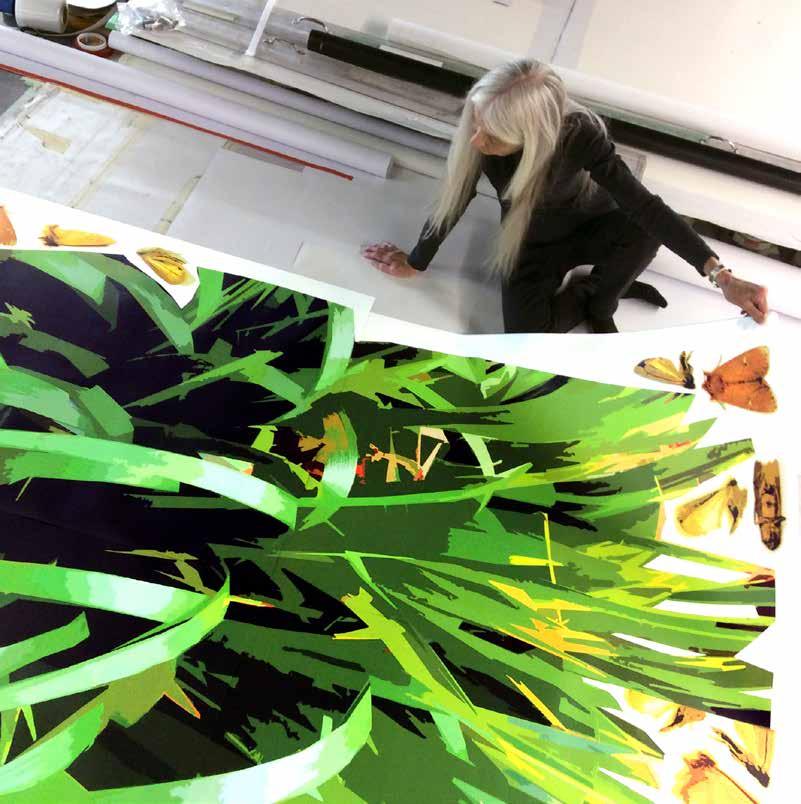
4 minute read
Fleurs du Mal: Introduction · Lubos Culen
FLEURS DU MAL: INTRODUCTION
The Fleurs du Mal is the latest exhibition created by Calgary based artist Alexandra Haeseker specifically produced to be on display at the Vernon Public Art Gallery. Haeseker’s studio practice has been focused on the critical context of existence of all living organisms and inevitably their coexistence and survival in this era of advancing climate change. She uses artistic means to convey messages about the state of the ecological impact of human activity upon the environment. The focus of Haeseker’s exhibition Fleurs du Mal is on the portrayal of plant matter and insects and their critical role in the ecosystems.
Advertisement
Haeseker’s studio practice is based on investigation and scientific research of various ecological elements. Her exhibition titled Fleurs du Mal focuses on the process of plant and insect decay and the images are used as references to the current climate situation, global warming, and the deterioration of ecosystems caused by the humans’ industrial and agricultural activity. In her research, Haeseker focuses on the observation and the collection of natural materials in her immediate surroundings. These include various plants which she then photographs and then further digitally manipulates. The final images are then printed in a large-scale format on recycled synthetic paper using UV Latex inks and then finally cut out so the plant elements exist as autonomous objects without the negative space. Her installations of plant based images are large in scale and on occasion they span from floor to ceiling. The installation of the artwork mounted off the wall results in a 3D appearance which is enhanced by claiming the whole gallery wall space.
The exhibition Fleurs du Mal consist of several large-scale floral elements complemented by a swarm of two hundred dead moth cut-outs, two artist books and a video. All plant elements are portrayed as decaying entities either by atrophy or insect damage. Upon the entry to the gallery space, the viewers can observe a large-scale cut-out of the Cicada known for their long cycles of hibernation. The image of the Cicada is complemented by an image of a decayed Trembling Aspen leaf. While the symbolic meaning behind the image of a Cicada is rebirth and beginning a new cycle, the image of a decayed leaf is a metaphor for the end of cycle.
The second wall is anchored by three large-scale elements. There is an image of flower and leaves with a spider, all in the colours we associate with the fall and hence the ending of a life cycle. The next element is the image of a dried floral stem which spans from the floor to the ceiling. It contains images of six caterpillars which metaphorically speaks of the cycle just before the re-birth into a flying insect. In addition to these three large elements, there are additional cut-out images of three moths, an announcement of the images of moths swarm which is situated in the corner of the walls three and four.
Wall three is dominated by large-scale leaves of vibrant purple colour and another cut-out image of an insect eaten Wood Violet leaf. Leading up to and situated in the corner is the beginning of two hundred cut-
out images of a swarm of the dead moths. Consequently, the rest of the ‘moths’ swarm is situated on the fourth wall. In addition to the multiple cut-out images of dead moths, there are two artist books displayed on two shelves. The sixteen page artist book titled Fallen Leaves is autobiographical in nature and feature images of various leaves juxtaposed over the text. The leaves were collected from different places where Haeseker lived. The texts, however obscured by the images of leaves, give the viewers glimpses into her associations of various places that she has been calling ‘home’. The second fourteen page Haeseker’s artist book titled Above the North is based on photographic images of frozen leaves encapsulated in ice and found in her driveway. The images were further digitally manipulated and the final appearance of the images resemble aerial views of Arctic tundra with lakes, roads and mountain ranges. In addition to the cut-out images of flora and insects featured in the exhibition, Haeseker produced a 15 minute video projected on the floor which features various dissolving images of fallen leaves on the forest floor.
Haeseker’s exhibition Fleurs du Mal asks the viewers to shift their focus regarding the environment and to contemplate what environmental changes have become obvious in our lifetime. Everything from melting glaciers, warming trends in the Arctic, raging forest fires, floods, or pine beetle infestation is an indication of permanent changes in the ecosystems we live in. Haeseker’s studio practice is guided by research concerning global changes and the artwork she produces is created within the context of scientific investigation. She uses her artmaking as the means of communication and encourages the viewers to contemplate the environmental changes on all levels.
Lubos Culen Curator Vernon Public Art Gallery



